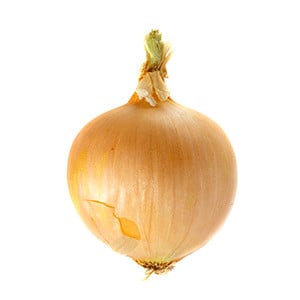Onion

Onion
Allium cepa
Plant family
Amaryllis family (Amaryllidaceae)
Season Overview
Propagating
Planting
Harvest
J
F
M
A
M
J
J
A
S
O
N
D
Details
Light requirement
Sunny
Water requirement
Moist
Soil
Medium (loamy)
Nutrient requirement
Medium
Plant distance
15 cm
Row spacing
20 cm
Seeding depth
1 cm
Instructions
The season for this plant is over. The following instructions are for the next season.
Beginning of January
Propagating
Beginning of January
Weeding
Every week
Beginning of February
Transplanting
Description
Perennial amaryllis plant, which in the first year forms the bulb as a storage organ. Onions include several groups: Leek and spring onions, shallots, summer or kitchen onions, and vegetable onions, all of which differ greatly in growth habit. Furthermore, a distinction is made between "summer", "spring" and "winter" onions. Our usual edible onion is called "winter onion" when it is sown in the fall, cultivated over winter, ripens the next spring and then harvested. Harvesting is a little earlier, but they become very soft and can hardly be stored. Therefore, the edible onion is usually sown or set as a "summer onion" in the spring. Then they can be harvested from July for direct consumption or from August to October for storage. There are also special cultivars of 'Allium cepa' as spring onions. They do not form bulbs, but long, soft stems and grow quickly. Due to the storage organ, the onions are adapted to rainfall fluctuations and drought. Nevertheless, to harvest large onions need a lot of water.
Origin:
Probably from Central Asia
Growing tips
A distinction is made between seed or plug onions. Summer, kitchen and vegetable onions are usually planted as plug onions in the spring. The plug onions are planted only deep enough to be just covered with soil. Sowing in the spring is also possible, and the bulbs are usually slightly smaller when harvested and can be planted as plug onions the following year. It is also possible to grow seedlings in planting trays. Then the seedlings are planted in the bed as soon as the 3rd-4th leaf is visible and as soon as no more severe frost is expected. Harvesting is done as soon as the leaves fold in by themselves and turn yellow and the leaf base dries up. To do this, you should wait for a dry, sunny day and let the bulbs dry out before storing them.
Companion Plants
Antagonistic Plants
Artichoke
Asparagus
Bean (Broad bean / Faba bean / Field bean)
Bean (Dwarf bean)
Bean (Runner bean)
Broccoli
Brussels sprouts
Cabbage (Cabbage)
Cabbage (Savoy cabbage)
Cauliflower
Collard greens (Kale)
Collard greens (Tuscan kale / Dinosaur kale / Palm tree kale)
Jerusalem artichoke / Topinambur
Kohlrabi / German turnip / Turnip cabbage
Leeks
Lovage
Napa cabbage / Chinese cabbage
Pak Choi
Pea
Pumpkin / Squash
Radish
Radishes
Soybean
Diseases
No diseases
Pests
Thrips
Stem borers
Leaf-miner flies
Onion fly
Wireworms